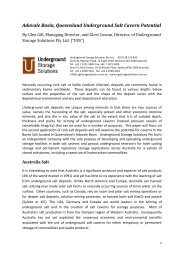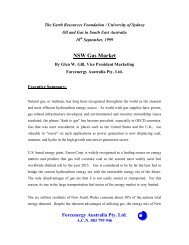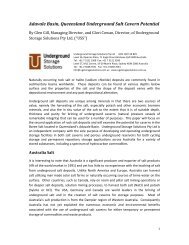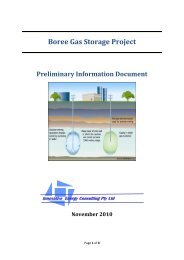Natural gas storage in salt caverns present trends in Europe
Natural gas storage in salt caverns present trends in Europe
Natural gas storage in salt caverns present trends in Europe
Create successful ePaper yourself
Turn your PDF publications into a flip-book with our unique Google optimized e-Paper software.
Wellhead pressure (bar)<br />
GILLHAUS, A. (2007): <strong>Natural</strong> <strong>gas</strong> <strong>storage</strong> <strong>in</strong> <strong>salt</strong> <strong>caverns</strong> – Present status, developments and future <strong>trends</strong> <strong>in</strong> <strong>Europe</strong><br />
150<br />
125<br />
100<br />
75<br />
50<br />
Seasonal peak shav<strong>in</strong>g by <strong>gas</strong> <strong>caverns</strong><br />
Januar 97 year #1 Januar 98 year #2Januar 99 year #3Januar 00 year Dezember #4 00<br />
Time<br />
Figure 5: Well head pressure of a <strong>gas</strong> cavern for saisonal <strong>storage</strong> <strong>in</strong>clud<strong>in</strong>g peak<br />
shav<strong>in</strong>g.<br />
Most of the exist<strong>in</strong>g <strong>gas</strong> cavern <strong>storage</strong>s <strong>in</strong> <strong>Europe</strong> were constructed <strong>in</strong> the past <strong>in</strong><br />
relatively simple, largely homogenous <strong>salt</strong> structures <strong>in</strong>clud<strong>in</strong>g thick bedded <strong>salt</strong><br />
sequences and <strong>salt</strong> pillows (e.g. Epe, Bernburg, Etrez), as well as <strong>salt</strong> domes (e.g.<br />
Nüttermoor, Ll. Torup) which developed from thick primary bedded <strong>salt</strong> sequences and<br />
<strong>salt</strong> pillows as a result of halotectonics. The stability and <strong>in</strong>tegrity of a cavern constructed<br />
<strong>in</strong> homogenous <strong>salt</strong> structures of this k<strong>in</strong>d is primarily determ<strong>in</strong>ed by the properties of the<br />
surround<strong>in</strong>g <strong>salt</strong> (Fig. 6).<br />
Figure 6: Influence of <strong>salt</strong> and non-<strong>salt</strong> on the <strong>in</strong>tegrity of <strong>caverns</strong> <strong>in</strong> homogenous and<br />
<strong>in</strong>homogeneous <strong>salt</strong> formations.<br />
The expansion or construction of new <strong>storage</strong>s is usually realised <strong>in</strong> favourable <strong>salt</strong><br />
formations of this type wherever possible. North Germany benefits from the frequent w<strong>in</strong>-<br />
w<strong>in</strong> situation where favourable locations from a <strong>gas</strong> bus<strong>in</strong>ess po<strong>in</strong>t of view are often<br />
page 11 of 18










